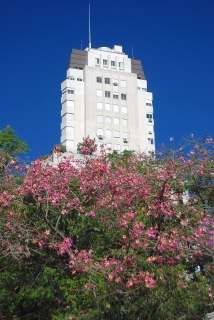Early Sunday morning, I left the tiny Chilean fishing port of
Taltal, with its dilapidated but atmospheric heritage of wooden buildings from the nitrate era, and headed into the coastal range of the Atacama desert - the shortest route north toward the city of Antofagasta and my ultimate goal of
San Pedro de Atacama. The coastal road north from Taltal turns to gravel after about 20 km and then, at the fishing village of Paposo, swerves up a steep canyon known as Quebrada del Despoblado - so called because nobody lives there and, given its stark aridity, that's not surprising.
Emerging on the high coast range, though, the road becomes smoothly paved and, about halfway to Antofagasta, a short

paved lateral climbs west to the European Space Organization's
Cerro Paranal Observatory (pictured here). I've been past it several times and had always wanted to visit the facility, but unfortunately they only offer public tours the last two weekends of each month (except December). This, however, was the last Sunday of the month and, although theoretically you need to make reservations well in advance, I figured I had nothing to lose by storming the gates, so to speak. It was also around 10:30 a.m., nearly four hours before the first scheduled tour but, in one of those occasional miracles that can make travel so memorable, a special tour was leaving almost as I arrived and I was able to talk my way onto it.
Cerro Paranal is one of the world's most sophisticated observatories, and each of the four buildings depicted above - very different from the traditional dome-style architecture - contains an eight-meter mirror lens; the four sometimes pool their efforts to increase the light and literally magnify the images they get from distant space. Visitors get to enter one of the buildings, accompanied by highly professional guides who handle both English and Spanish, and also get to visit the control room (which was extremely quiet on this Sunday). The highlight for many visitors, though, is the so-called "Perla de las Dunas," the astronomers' hotel

that ostensibly went up in flames in the latest James Bond saga,
Quantum of Solace. The photograph here is not the corridors where 007 and his companion fought off the bad guys, but rather the central dome garden - which looks unreal compared to the desert outside, where not a blade of grass grows. As it happened, when the guide learned that I was press and that we had a mutual friend from La Serena, I got special treatment to get a closer look where the rest of group - mostly students from an Antofagasta high school - couldn't go.
All in all, a remarkable stroke of good luck that left me in a great mood on the

rest of the long day's drive to San Pedro (about which I'll write more in the coming days). Meanwhile, en route, I stopped in the village of Baquedano, whose vintage
train station (pictured here), about which I wrote more in an earlier post, was also a location for Quantum of Solace. That, though, was enough Bonding for the day, and I got back on the road to San Pedro, arriving around 7 p.m.
 pretty good deal - nearly three times the price he had paid in pesos - but had he sold a few months earlier, when the peso was at par with the dollar, he would have done even better.
pretty good deal - nearly three times the price he had paid in pesos - but had he sold a few months earlier, when the peso was at par with the dollar, he would have done even better.









